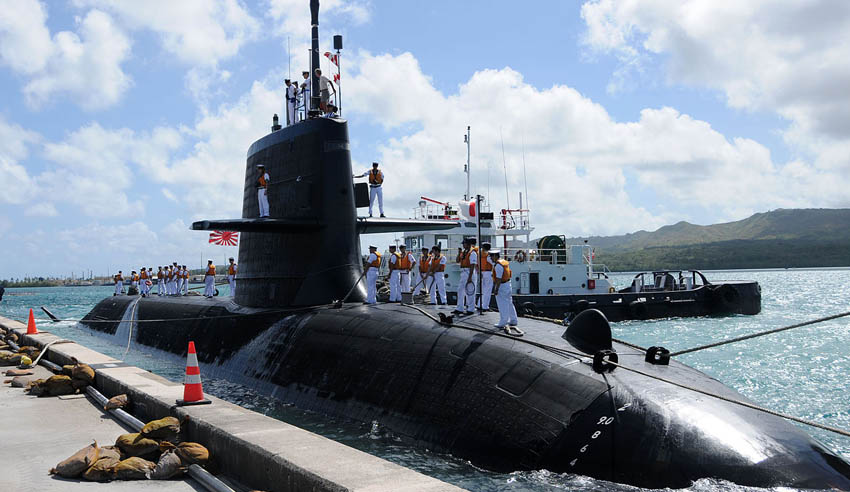As Australia’s own $50 billion Attack Class submarine program enters the design phase, Japan, one of the contenders for the program, has commenced research, design and development for the successor to its Soryu Class, which entered service in 2009 – again raising questions about Australia’s delivery time frames.
Japan’s Soryu Class is widely recognised as one of the world’s best submarines and often acknowledged to be the world’s most advanced, quietest, conventionally powered submarine. The diesel-electric vessels weigh in at approximately 4,000 long tonnes and are Japan’s largest post-war submarines, providing an important tactical and strategic edge over competitors.
Designed from the keel up to have an operation life of about 20 years, approximately half of comparable vessels operated by nations, including Australia, Japan’s planned fleet of 15 Soryu Class has recently been upgraded to include large banks of advanced lithium-ion batteries as a quiet source of power and is one of the major technological breakthroughs expected to be included in the next generation of attack submarines.
Mitsubishi Heavy Industries, Japan’s leading submarine builder, has unveiled provisional designs for what is tentatively being designated the 29SS submarine design – with the first submarine due to be introduced in service in late-2020s. The research and development phase will take place from 2025 to 2028, and the first ship of this class will probably hit the water around 2031.
Noted submarine authority HI Sutton said 29SS is a “new design... based on the Soryu class, with its distinctive bow form and hull outline, but [it] differs significantly in the sail and hydroplane arrangement”.
It is expected that while the 29SS submarine will retain the general hull form of the earlier Soryu Class vessels, the new vessels will incorporate a range of important design changes, including a substantially reduced sail, which is expected to be blended into the hull with the aim of reducing hydrodynamic drag, helping to lower the noise signature of the submarines, while the dive planes will be moved from the sail to the hull.
Additionally, it is expected that the 29SS will include a pumpjet as opposed to the traditional propeller for propulsion, in a similar fashion to what is expected to be introduced on Australia’s future Attack Class submarines.
29SS will likely retain the same armament as the Soryu boats, which consist of six bow-mounted 533-millimetre torpedo tubes. The submarine can carry up to 30 torpedo-launched weapons, a mixture of the Type 89 heavyweight torpedo and the Sub Harpoon anti-ship missile. Although there is a general trend towards installing vertical launch silos behind a submarine’s sail, Japan does not have the missiles to fill them.
Pumpjet propulsion provides propulsion by sucking in water and ejecting it under pressure, providing quieter propulsion and are expected to be significantly more maneuverable than bare propellers and are generally standard on larger, faster nuclear-powered submarines.
Japan operates one of the largest submarine fleets in the world, centred on a highly capable, modern fleet of conventional attack submarines that are used to conduct maritime interdiction, anti-shipping, anti-submarine and patrol operations of Japan’s maritime approaches and zones.
This rapid turnaround of submarine research, development, design and manufacturing process across a large number of submarines raises some poignant questions about the delivery time frame for Australia’s own $50 billion SEA 1000 Attack Class program.
Australia’s fleet of Attack Class submarines have recently entered the next stage in the design phase, with the Naval Group Shortfin Barracuda serving as the basic design for the Attack Class. The Attack Class vessels will begin replacing the ageing Collins Class vessels at a time when 50 per cent of the world’s submarines will be operating in the Indo-Pacific region.
The 12 vessels will be built by Naval Group at a specialist submarine shipyard at Osborne, South Australia. The Commonwealth government’s Australian Naval Infrastructure program will support the development of the future submarine shipyards. The Commonwealth government formally signed the strategic partnering agreement with Naval Group in February 2019 ahead of confirming the final design specifications and requirements for the Attack Class submarines.
Naval Group Australia’s involvement in this $50 billion project, supporting an annual average of about 2,800 jobs, amounts to more than just the design and construction of 12 submarines for the Australian Navy – and will also bolster local industry, create thousands of jobs and transfer world-class technology, knowledge and expertise to Australia.









